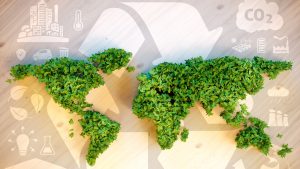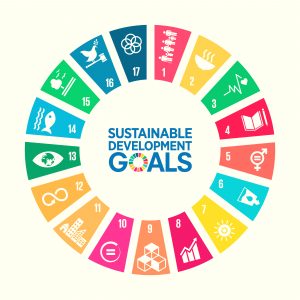Any positive change that happens in a society, country or any field is called development. Positive change is a method that implements progressive initiation and helps in qualitative performance. Moreover, Positive change ensures growth in physical, economic, environmental, social, and demographic components.
Things that maintain and retain their quality at a certain level are sustainable. Sustainability mainly focuses on the needs of the present scenario and meets the requirement of a future generation too. And, economic, environmental, and social are the three compositions of sustainability which also means profit, planet, and people respectively.
Sustainable development: Introduction
According to the Brundtland Report, “Sustainable development is the development that meets the needs of the present without compromising the ability of future generations to meet their own needs.” Apart from basic needs, it offers relationships, freedom, values, etc.
Sustainable development requires every basic need extending all the opportunities to satisfy their upcoming generation. Further, it includes consistency in qualitative development that runs for a long time. It deals with the situation for both the present and future without entertaining the destruction of the environment and natural resources.
The slogans of sustainable development are famous among rally and protest of environmentalists and conservationists. In addition, a lot of people, country, and society have embraced this concept as it can be continued indefinitely or at a specific time.
A brief history to present context
In 1987, the United Nations World Commission on Environment and Development published a report (The Brundtland) where they mentioned the term “sustainable development” with a definition. Later on, in 1992, the same UN commission prepared the concept of sustainable development. Although in 1972, a similar concept was proposed in a conference without terming sustainable development.
The major debate that helped in the recognition of sustainable development was the discussion for the continuous support to the increasing population by the capacity of limited natural resources. And, it concluded that if the action against the rapid population growth will not be taken, it results in the depletion of the environment and natural resources.
Communism: Basics one ought to know
But, coming to this point in time, even if the concept of sustainable development has gained popularity in papers, the execution of plans is poor. While natural evolution has also halted the theories it requires the generation and application of creative ideas and innovative designs. However, the UN has failed to partner with governments and other concerned bodies for the new systems.
Pillars of sustainable development
Sustainable development focuses on three fundamental visions known as pillars. Further, they are economic sustainability, social sustainability, and environmental sustainability.
The economic sustainability deals with the business from the ground. Moreover, it mainly focuses on the profit of the business. Further, it includes compliance, proper governance, risk management, etc. Nevertheless, it also provides the proper and legit platforms for corporates, shareholders, customers, and board of directors.

On the other hand, social sustainability concerns the development of people and emphasizes empowerment, participation, equity, and accessibility. And, it also aims for the alleviation of poverty within the existing environmental and economic resources. Further, it also directs the development of communities and culture to gain peace, stability, healthcare, and a proper lifestyle.
Similarly, the third pillar, environmental sustainability determines the margin and relation between the environment, natural resources, and human life. Also, it tries to maintain equilibrium on various factors as the ecosystem has its specific limits and boundaries. Notably, climate changes, natural disasters, and global warming are the major focus in this scenario.
Principles and Goals
The Rio Declaration on Environment and Development (1992) listed the 18 principles of sustainable development. These 18 points mainly highlight the interdependence, participation, providing information, and improving science on development activities. Further, they also provide, support, and improve intergenerational equity and durability with the rules of governance. In particular, they are ensured to maintain and enhance the quality of society (via. community building), human life, environment, and economic vitality.
The 18 principles of sustainable development are as follows:
1. People are entitled to a healthy and productive life in harmony with nature.
2. Development today must not undermine the development and environment needs of present and future generations.
3. Nations have the sovereign right to exploit their own resources, however without causing environmental damage beyond their borders.
4. Nations shall also develop international laws to provide compensation for the damage that activities under their control cause to areas beyond their borders.
5. Moreover, nations shall use the precautionary approach to protect the environment. And, where there are threats of serious or irreversible damage, scientific uncertainty shall not be used to postpone cost-effective measures to prevent environmental degradation.
6. In order to achieve sustainable development, environmental protection shall constitute an integral part of the development process and cannot be considered in isolation from it.
7. Eradicating poverty and reducing disparities in living standards in different parts of the world are essential to achieve sustainable development and to meet the needs of the majority of people.
8. Nations shall cooperate to conserve, protect and restore the health and integrity of the Earth’s ecosystem. And, the developed nations should acknowledge their responsibility for sustainable development.
9. Nations should reduce and eliminate unsustainable patterns of production and consumption and promote appropriate demographic policies.
Great Organizations Working To Stop World Hunger
10. Environmental issues are best handled with the participation of all concerned citizens. Therefore, nations shall facilitate and encourage public awareness and participation by making environmental information widely available.
11. Nations shall also enact effective environmental laws and develop national laws regarding liability for the victims of environmental damages. And where they have authority, nations shall assess the environmental impact of proposed activities that are likely to have a significant adverse impact.
12. Nations should cooperate to promote an open international economic system. It will lead to economic growth and sustainable development in all countries. Environmental policies should not be used as an unjustifiable means of restricting international trade.
13. The polluter should, in principle, bear the cost of pollution.
14. Nations shall warn one another of natural disasters or activities that may be harmful transboundary impacts.
15. Sustainable development requires a better scientific understanding of the problems. Nations should share knowledge and innovative technologies to achieve the goal of sustainability.

16. The full participation of women is essential to achieve sustainable development. And, the creativity, ideas, and courage of youth and the knowledge of indigenous people are needed too. Nations should recognize and support the identity, culture, and interests of indigenous people.
17. Warfare is inherently destructive of sustainable development. In times of armed conflict, nations shall respect international laws, protect the environment and shall cooperate in the establishment of sustainable development.
18. Peace, development, and environmental protection are interdependent and indivisible.
Goals:
Likely, goals are always determined by the principles and their proper execution and implementation. In 2015, The General Assembly of the United Nations prepared 17 goals of sustainable development and aimed to achieve it by 2030.
Read the details of sustainable development goals here!
The 17 goals are No Poverty, Zero Hunger, Good Health and Well-being, Quality Education, Gender Equality. Clean Water and Sanitation, Affordable and Clean Energy and Decent Work and Economic Growth. Further, they are Industry, Innovation and Infrastructure, Reducing Inequality, Sustainable Cities and Communities. Responsible Consumption and Production, Climate Action, Life Below Water. And lastly, Life on Land, Peace, Justice, and Strong Institutions, and Partnerships for the Goals.
Importantly, the final and ultimate aim of sustainable development is to achieve equilibrium among economic, social, and environmental sustainability. However, there are a lot of challenges that lower the pace of sustainable development. And, radical improvements in eco-efficiency and fundamental renewal in technological systems can fix many of the problems.
For more, keep following Wikye.com









